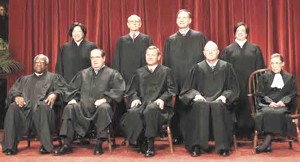Supreme Court creates affirmative inaction
5th May 2014 · 0 Comments
By Zenitha Prince
Contributing Writer
(Special to the Trice Edney News Wire from the Afro American Newspaper) — A Supreme Court decision, April 22, upholding states’ right to ban the use of race-sensitive policies in university admissions wielded a serious blow to affirmative action, experts said, and shifts the battleground to the states.
“Many voices in the civil rights community will call this decision a major disappointment because it weakens the options for insuring diversity in our public institutions,” said Jose Anderson, professor of law, University of Baltimore.
“Advocates of affirmative action are going to have to work harder than ever before to attempt to sustain its viability.”
University of Maryland law professor Larry Gibson, however, saw the glass as being half-full.
“It doesn’t by itself do as much damage as I feared it might. The fight we’ve been having is whether affirmative action was constitutionally permissible and it remains so—unless it is banned by a state Constitution,” Gibson said. “The negative side is that [the decision] will probably encourage other states to enact similar bans.”
Justices voted 6-2 in the case brought by the Coalition to Defend Affirmative Action, Integration & Immigrant Rights, and Fight for Equality By Any Means Necessary (BAMN) against the state of Michigan, whose voters approved an initiative banning racial preferences in university admissions.
The measure, called Proposal 2, was passed by 58-42 percent of voters in 2006, but has been embroiled in legal challenges for almost a decade.
In 2008, a District Court upheld Proposal 2, but the Sixth Circuit Court of Appeals reversed the lower court’s judgment in 2011. With the Supreme Court’s ruling today, the Michigan law is back in force.
The high court’s decision was not unexpected, Anderson said.
“The Supreme Court has always been very cautious about approving specific affirmative action plans,” he said. “The basic idea of diversity has occasionally obtained support by justices, beginning with the Bakke case in 1978, but it has always been difficult to get the vote to uphold specific programs.”
Justice Anthony Kennedy, in his opinion shared by Justices John Roberts Jr. and Samuel Alito Jr., said the ruling did not weigh the viability of affirmative action policies. Justices Antonin Scalia and Clarence Thomas joined in a separate concurring opinion and Justice Stephen Breyer offered another concurring opinion.
“This case is not about the constitutionality, or the merits, of race-conscious admissions policies in higher education,” Kennedy wrote. “…The holding in the instant case is simply that the courts may not disempower the voters from choosing which path to follow.”
Justice Sonia Sotomayor’s exhaustive 58-page dissent suggested such reasoning was a cowardly retreat from the persistent problems of race and from the high court’s duty to uphold equal protection for all citizens.
“Without checks democratically approved legislation can oppress minority groups,” she wrote in an opinion shared by Justice Ruth Bader Ginsburg.
The majority in Michigan reconfigured the political process, creating a “two-tiered” system “that burdened racial minorities,” she added. According to Michigan’s law, raced-based admissions proposals have to overcome a challenge to the state Constitution, while other proposals—such as those based on athletics or legacy—simply have to go to school boards.
The majority “effectively rigs the contest to guarantee a particular outcome,” Sotomayor, an affirmative action beneficiary, said.
Sotomayor further argued that the court’s decision would lead to a drop in minority enrollment and, therefore, to less diversity, citing outcomes in California and other states with similar policies to Michigan’s.
“The statistics I have described make that fact glaringly obvious,” she said.
Civil rights groups agree with Sotomayor’s assessment.
“Today’s Supreme Court decision is a step backward for racial inclusion by allowing voters to overrule the decision of Michigan University officials to consider race in admissions to achieve diversity,” said Jon Greenbaum, chief counsel for the Lawyers’ Committee for Civil Rights Under Law, in a statement. “The Court has disregarded long-standing precedent which prevents the majority from passing legislation that reconfigures the political process in ways that burden only a racial minority.”
In addition to Michigan and California, Florida, Washington, Arizona, Nebraska, Oklahoma and New Hampshire have similar prohibitions on racially-conscious admissions policies.
The court’s ruling does not impact affirmative action programs in the 42 other states.
This article originally published in the May 5, 2014 print edition of The Louisiana Weekly newspaper.




